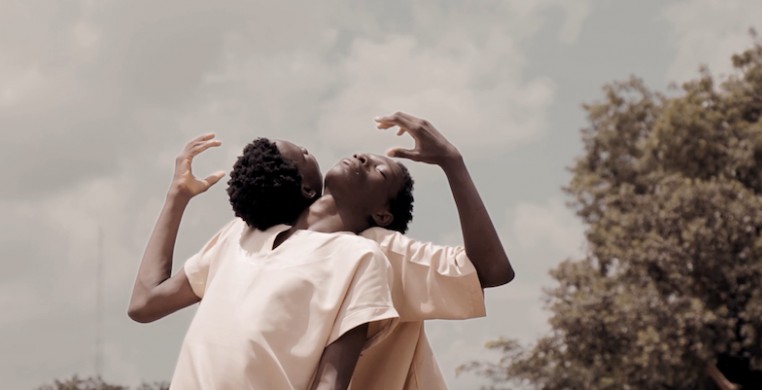By the time I began writing this review I’d probably seen “Kaduna” 20 times. I watch it before I go to bed, when my son takes a nap or when I simply want to feel something. As I mold emotions to form, I smile. The marriage of movement and film is the formal union about which I’m most excited these peculiar days.
“Kaduna” is the first film in a series of weekly premieres called Films.Dance, produced by Jacob Jonas The Company and viewable on the Harris Theater’s new Virtual Stage. Performers the Ebinum brothers take us on a geometric journey in earth-toned garments under an overcast Nigerian sky. Kaduna, the name of a port city in Nigeria, doubles as the title of the 5-minute dance film choreographed by Vinson Fraley. Exhausting the possibilities of a duet, the brothers complement, crawl around, mirror, comfort and confront one another as they pilgrimage to an unknown destination. Appearing much like the contact improv style of movement placed upon the men, it is clear the exchanges of weight and tender touches are mindfully intended for us to enjoy a journey of double consciousness.
The support system of the duet serves as a reminder that we can no longer afford the luxury of tunnel vision. The brothers’ interactions encourage us to consider the burdens we place on one another, as well as on the earth. With each press, caress, lift and lean theirs is an explicit exploration of kinship. We see this in relation to the rocks beneath their bare feet, to the abandoned boat the brothers rest upon and to the singing turned crying women who appear sonically at the beginning of film and visually in the end. As viewers, we are constantly negotiating our focus with the visible and invisible, the conscious and unconscious, the physical and the spiritual, eventually taking into consideration that all of life requires partnership.
The second premiere was released Feb. 1, a dance film called “Toke” by choreographer and dancer Toke Broni Strandby. Simply put, “Toke” is beautiful, with stunning backdrops and exquisite sound. The dancing is fascinating and the lighting serves its purpose: to illuminate the entirety of the choreographer. Utilizing the full breadth of the crew, “Toke” takes us on a five-minute personal journey with Strandby through silhouettes, grassy mountains and the clean architecture of London. In the opening scene, he wears a beige linen tarp heaving with a heavy torso up and down on repeat; the camera zooms out to find him smack and center of a geometrically patterned ground.
As Strandby began to speak, I realized this may be the first time in recent dance and film collaborations that I’ve heard from dancers in a narrative format. His lean, defined body moves with the spirit of something more. By speaking candidly about his discomfort with being referred to as a disabled dancer (he does not have a left forearm or hand), one begins to question the term disabled in the first place. What is a disabled dancer? What makes a dancer disabled? Why was he not considered disabled until he danced? Perhaps the disability is more in the people who are unable to celebrate our human diversity without placing us in a box. This is a dancer/choreographer I look forward to seeing and hearing more from in the future.
--
Films.Dance continues through May 3, with weekly premieres launched Mondays at 11:00 a.m. The films are available to view for free on the Harris Theater’s HT Virtual Stage throughout the duration of the series. For more information, visit the Harris Theater's page, linked below.


